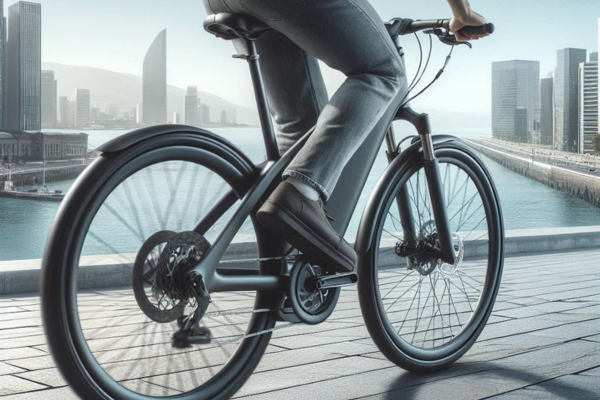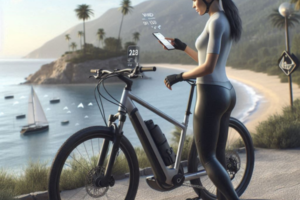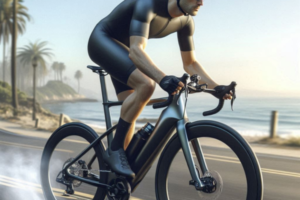🛞 Understanding Tire Aerodynamics in E-Bikes
When discussing aerodynamics in electric bicycles, most people immediately think of frame geometry, rider posture, or helmet design. However, one of the most overlooked factors contributing to wind resistance is the tires. Not only do tires influence rolling resistance and traction, but their shape, size, and tread pattern also affect how air flows around your bicycle — especially at higher speeds.
While electric bikes are rarely traveling at the speeds of professional racing bicycles, the effects of air resistance are still measurable, particularly for commuters, delivery riders, and long-distance urban cyclists. Wind resistance increases with speed, and tires — being the first point of contact with both the road and incoming air — play a crucial role in this dynamic.
🌬️ How Tires Contribute to Drag
Aerodynamic drag occurs when moving air is disrupted by the surfaces of a bicycle and its rider. The bulk of that drag typically comes from the frontal area of the system — including the wheels and tires. A wider or knobbier tire creates more turbulence in the surrounding air, which in turn increases drag. Conversely, a smoother, narrower tire maintains cleaner airflow, reducing aerodynamic resistance and improving efficiency.
The magnitude of this effect depends on several variables, including:
- Tire width: Wider tires present a larger surface area to incoming air, increasing frontal drag. Though they offer more comfort, they can reduce aerodynamic efficiency at higher speeds.
- Tread pattern: Aggressive treads can disrupt airflow, especially on front tires, which are the first to contact the air as you move forward.
- Tire pressure: Underinflated tires deform more, increasing the surface area exposed to wind and road, indirectly raising both rolling and air resistance.
While tire resistance is often discussed in terms of energy loss to road friction, it’s the combination of rolling resistance and aerodynamic resistance that ultimately defines how hard your motor needs to work — and how much range you can expect from a full charge.
🔍 Frontal Area and Its Impact
In aerodynamics, “frontal area” refers to the total surface facing the wind. For a bicycle, this includes the rider’s body, the handlebars, and — importantly — the wheels and tires. A tire with a larger profile increases this surface area and disturbs the air around it, creating more drag. This becomes especially relevant in windy conditions or on long open roads where consistent speed is maintained.
In fact, many aerodynamic studies in cycling indicate that up to 10% of total drag can come from the wheels and tires. That’s a significant percentage when considering energy efficiency in an electric system. Even modest improvements in tire choice and configuration can produce measurable differences in performance.
🚲 Tire Width: Balancing Comfort and Air Resistance
Many electric bicycles come equipped with wider tires — sometimes 2.0 to 2.5 inches or more — especially in commuter, utility, or cargo models. These tires offer increased stability, better grip on uneven surfaces, and a more comfortable ride. However, they also introduce greater wind resistance compared to narrower options.
Wider tires increase the frontal area of the bike, especially when combined with upright frames and fenders. In headwind scenarios or at speeds above 25 km/h, this additional surface can significantly contribute to drag. For riders who prioritize efficiency, a narrower tire (in the range of 28mm to 38mm) may offer a better balance between comfort and aerodynamic performance — especially on paved roads.
That said, it’s essential to match tire width to riding conditions. In wet or sandy coastal cities, the slight increase in rolling stability provided by wider tires can be valuable, even if it comes at a minor aerodynamic cost. The key is understanding when a wider profile is worth it — and when it’s slowing you down unnecessarily.
⚙️ Tread Design and Wind Flow
The tread of a tire doesn’t just interact with the road surface — it also affects how air moves around the tire itself. Knobby or rugged treads, common on off-road or fat-tire e-bikes, can disrupt laminar airflow and create micro-turbulence along the spinning wheel. This leads to increased air drag and can generate more resistance than expected.
Smooth or slick tires, often found on hybrid or urban e-bikes, allow air to move more smoothly across the wheel surface. While they may lack the off-road traction of knobby tires, their aerodynamic profile can improve ride efficiency in daily commutes or long flat rides where airflow is consistent.
In a study by Bicycle Rolling Resistance Lab, slick tires showed a 2–4% aerodynamic efficiency improvement compared to similarly sized tires with pronounced tread, even at moderate speeds. For electric bicycles, where every watt matters, this efficiency gain translates into real savings in battery life.
📏 Tire Pressure and Deformation
Another key factor in wind resistance is how much the tire deforms while in motion. Underinflated tires flatten at the contact patch, widening the tire’s footprint and presenting a larger area to both road and air. This not only increases rolling resistance but also disturbs the flow of air around the wheel, adding drag.
Keeping your tires inflated to the recommended PSI ensures a more uniform shape and minimizes surface contact with both the ground and the air. Overinflation can also be counterproductive, reducing comfort and control — especially in humid or slippery environments — so it’s about finding the right balance for your terrain and load.
🔄 Rotational Drag: How Spinning Tires Create Resistance
Tires don’t just face drag because of their shape — they also create resistance as they rotate. This is known as rotational drag, and it occurs because each segment of the spinning tire interacts with the air at varying speeds and angles. The faster the wheel spins, the greater this interaction becomes, and the more resistance is generated.
In the automotive world, wheel aerodynamics are optimized with wheel covers, rim shapes, and tire-wall transitions. For e-bikes, the same logic applies — especially when using deep-section rims, fat tires, or spoked wheels with large gaps. These elements introduce air turbulence and affect how the bike cuts through wind at speed.
To reduce rotational drag:
- Use tires that are well-fitted to the rims, avoiding excess width that protrudes into the airstream.
- Consider using wheel covers or aerodynamic inserts on high-speed commuter bikes.
- Keep wheels clean — mud or dust buildup on treads increases turbulence and energy waste.
In humid environments where moisture often coats roads and tires, even small layers of water or debris can increase drag by affecting tire symmetry and airflow. Routine cleaning isn’t just about aesthetics — it’s part of maintaining aerodynamic integrity.
🌫️ Impact of Environmental Factors
In coastal cities or tropical climates, humidity and wind interact with tires in specific ways. Wet roads increase rolling resistance, especially if tires aren’t designed to shed water efficiently. Wider treads retain moisture and small debris, which not only slows you down but can cause imbalance at speed.
Crosswinds also have a greater effect on larger tires. When wind hits the sidewall, it pushes the rider slightly off balance, especially with high-profile tires. This not only affects control but also causes subtle rider movements that disrupt posture and increase total frontal area — compounding drag.
To minimize these effects in humid environments:
- Use directional tread patterns that help evacuate water from the contact area.
- Keep your tire pressure slightly higher (within safe limits) during rainy or humid conditions to avoid deformation.
- Consider using sidewalls with reduced surface texture to deflect crosswinds more efficiently.
These optimizations are subtle but add up — especially on long commutes or routes with mixed weather exposure.
🚴 Choosing the Right Tire for Aerodynamic Efficiency
Choosing the right tire for your electric bicycle depends on a combination of terrain, rider weight, speed, and weather conditions. However, when it comes to minimizing wind resistance, some clear guidelines emerge from both cycling and automotive research.
For riders who prioritize speed and range, narrower slick tires in the 28mm to 38mm range are generally more aerodynamic. They cut through the air with less disruption, maintain a rounded shape under pressure, and create less rolling deformation. These tires are ideal for urban roads, dry climates, and long commutes with consistent surfaces.
On the other hand, riders who frequently encounter rough roads, gravel, or wet environments may benefit from slightly wider tires with light tread. While they may increase drag slightly, the improved grip and safety outweigh the aerodynamic cost in many real-world situations.
Many manufacturers now offer e-bike specific tires with aerodynamic profiles — including contoured sidewalls, advanced rubber compounds, and sealed beads. These tires combine low rolling resistance with improved airflow behavior, offering the best of both performance and safety.
🛠️ Practical Tips to Reduce Tire-Induced Drag
Beyond choosing the right tire, there are several maintenance and setup practices that help reduce the aerodynamic drag associated with tires:
- Check tire alignment: Misaligned tires or skewed wheels can increase drag and reduce efficiency. Ensure your wheels are centered and spin evenly.
- Inspect for damage: Worn or uneven tread affects airflow and can increase rolling resistance. Replace tires that have flat spots or severe wear.
- Maintain proper inflation: Regularly check pressure using a digital gauge and adjust according to your riding weight and tire specifications.
Even small efforts here can translate into more efficient rides. For example, a properly aligned and inflated tire can reduce drag and rolling resistance by several watts — a meaningful difference for electric bikes relying on limited battery capacity.
🔧 Integration with E-Bike Design
Just as the automotive industry integrates tires into the full aerodynamic profile of the vehicle, modern e-bike design is beginning to follow suit. Frame designers now consider how tire size and placement interact with fenders, forks, and even motor housings. The goal: a smoother flow of air from front to rear.
Low-profile fenders, fork fairings, and internal routing can help reduce the drag caused by turbulence around the tires. Some premium e-bike brands even test wheel combinations in wind tunnels to refine how tires contribute to the bike’s overall coefficient of drag (Cd).
By treating the tire as a key component of the aerodynamic system — rather than just a rubber ring — riders and designers alike can extract more performance from the same amount of energy.
📊 Real-World Impact: Range, Speed, and Comfort
While aerodynamics is often associated with professional racing, its impact on everyday electric bicycle usage is very real. By selecting and maintaining tires that support efficient airflow, riders can experience tangible benefits — such as longer battery range, smoother handling, and improved speed with less effort.
For instance, reducing rolling and wind resistance through optimized tires can yield a 5–10% improvement in total system efficiency. That means more kilometers per charge, reduced strain on your motor, and lower long-term maintenance. This is particularly beneficial in coastal cities or humid climates, where environmental resistance is naturally higher.
Many riders mistakenly overlook tire choice, focusing instead on battery size or motor wattage. But as shown in both cycling and EV engineering studies, aerodynamic optimization often offers greater gains per dollar invested than simple hardware upgrades. And in many cases, all it takes is the right set of tires — and smart setup choices.
🔬 Future Innovations in Tire Design
The future of electric bicycle tires will likely bring even greater attention to aerodynamic behavior. Some leading manufacturers are already experimenting with:
- Graphene-infused compounds for reduced rolling resistance and better air deflection.
- 3D-printed sidewalls optimized for wind flow at specific angles.
- Active tread technology that adapts to speed and weather, reducing drag dynamically.
As these technologies trickle down from racing and automotive sectors into the e-bike market, we can expect tires to become not just functional — but strategic tools for maximizing efficiency and performance.
💬 Final Thoughts
Your tires are more than just rubber—they are critical aerodynamic components that shape how your electric bicycle performs in real-world conditions. From their width and tread to their pressure and position, every aspect affects how efficiently you move through the air.
By understanding and optimizing the aerodynamic impact of your tires, you can ride smarter, go farther, and make better use of your e-bike’s power. Whether you’re commuting across town or exploring the coast, the right tires can make your journey smoother, faster, and more energy-efficient.
Have you noticed a difference in your e-bike’s performance after changing your tires? Share your experience in the comments and help other riders make informed choices for safer, smarter cycling.



